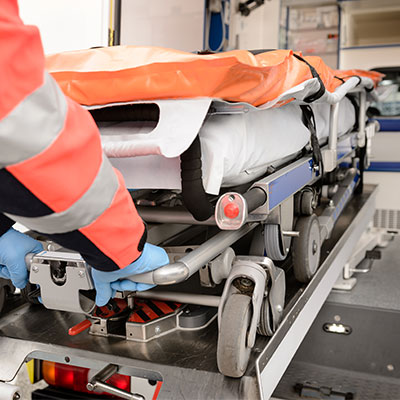When it comes to emergency stretchers, the right one can make a world of difference in responding quickly and effectively to emergency situations. First responders and EMS medical personnel know that accuracy, versatility, speed, and comfort are key factors when it comes to making the right choice for your team’s needs.
Certain ambulance stretchers are better at some applications than others. Don’t rely on just any old patient transport stretcher; learn more about the options for ambulance stretchers and how to choose the right one for your fleet.
Know Your Stretcher Options
It’s important to understand which type of stretcher is best for your needs. Ambulance stretchers (ambulance cots) are designed for different types of care and emergency transport.
There are soft stretchers, like the Skil-Care Emergency EVAC Transporter. This type of nylon stretcher is used to transfer or rescue patients where typical, metal stretchers can’t go, such as dense forests or deserts. Soft stretchers are great to have as part of your equipment arsenal because they can be used in a range of difficult types of terrain.
Similarly, the MegaMover Plus is another soft stretcher, with the option for a backboard to be added for extra stability. Backboards are crucial in protecting the patient’s neck and spine. So, when a neck or spinal injury is suspected, backboards are essential when immobilizing the patient in order to prevent further injury.
For common stretchers, there are different kinds of metal and framing components to consider.
Metal Stretchers
-
- Aluminum alloy stretchers are lightweight and sturdy, able to handle heavier patients.
- Steel stretchers are quieter and more durable, but are heavier.
Different Frames
-
- An X-frame stretcher, also known as a spine board, is designed to immobilize the patient’s spine.
- An H-frame stretcher is a scoop stretcher. It’s for patients who have suffered a fracture or other type of limb injury. These are usually lightweight, like aluminum alloy.
Just like in their names suggest, an X-frame has a frame underneath the stretcher that forms an X, while an H-frame is open.
Chair Options
When researching stretchers for your first response vehicle, it’s worth looking at evacuation chairs, also called escape chairs or stair chairs.
These are not typical stretchers or home care apparatus. They are chairs that first responders use to secure a patient and safely get them up or down stairs or out of a medical emergency where there is an incline. They should only be used by professionals who have training on how to properly move a patient.
Inclusive Stretchers
It’s always important to keep weight capacity in mind when researching ambulance stretchers.
Need a stretcher that has bariatric capabilities? The foldable Ferno Power X1 has a 700-pound load capacity and includes both FERNO-Washington and Stryker solutions.
Along with weight capacity, it’s worth double checking the length and width of EMS stretchers, not only for patients but also to ensure that they fit in your medically equipped vehicle.
While it may seem logical to only store ambulance stretchers that have a higher weight capacity to fit all patient sizes, that is not necessarily the case. Patient transport stretchers should have the ability to immobilize and transport small patients, as well. Pediatric patients need to be safely secured to the stretcher, so restraints, belts and other types of medical equipment suited for larger patients are often not safe for children.
Secure Children
Pediatric patient transport has its own special concerns, requiring equipment that is specifically designed for them. If the pediatric patient needs immobilization, EMS professionals can utilize a pediatric immobilization board or pediatric vacuum mattress. This allows for the patient to be transported without increasing the risk of neck or spinal injury.
Smaller ambulance stretchers are available for all sizes and weight capacities, including neonatal, infant, and pediatric options.
Powered Stretchers
Another way to offer high-quality patient care is by considering a powered stretcher. What are the benefits of powered stretchers as opposed to more conventional options? Most importantly, there’s a reduced risk to not only the patient but also to the EMTs. Stability while moving the patient to and from the vehicle is also increased.
The Ferno iNX Integrated Patient Transport stretcher, also an X-frame, allows medical personnel to load patients with a button, not straining their bodies no matter the size of the patient. The stretcher also has the functionality for the backboard to become a medical chair, allowing patients with breathing limitations to sit upright during transportation while acting as a backrest.
Ambulance Stretchers Available at Penn Care
Examine Warranties
The warranty is important because it allows you to return the stretcher if it is faulty, whether it’s refurbished or brand-new. Similarly, you want to be able to get a replacement if the stretcher is damaged in transport.
Don’t hesitate to replace your medical stretcher if it is damaged. Using a damaged stretcher can result in injury to the patient and puts the care provider at risk, as well. Whether the damage fits under warranty or not, replace any damaged ambulance stretcher as soon as possible.
Penn Care Has Your Stretcher and Equipment
With the right medical supplies, you can deliver the best care while also keeping your first responders safe. For your healthcare equipment needs, from ambulance stretchers to fasteners and side rails, contact Penn Care today!



